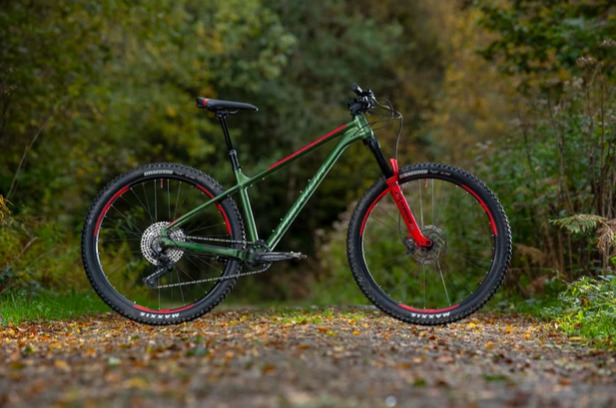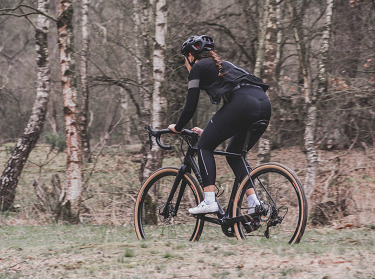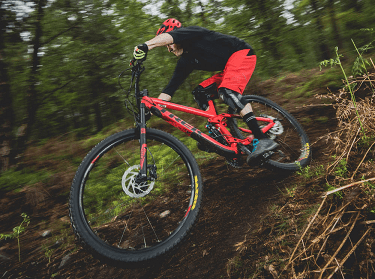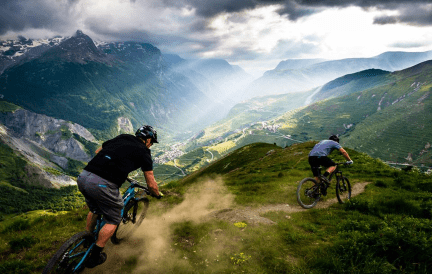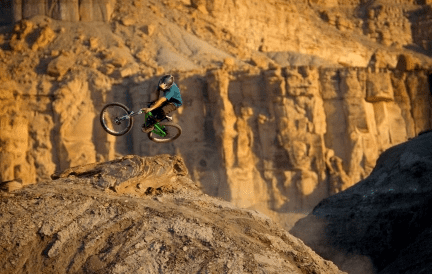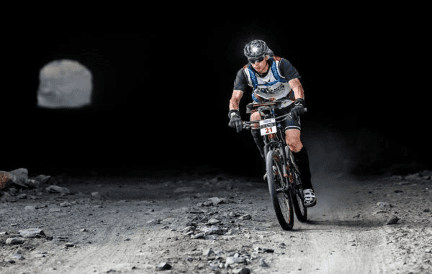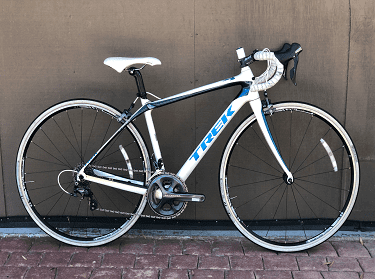If you like a more pleasant ride, the best full suspension mountain bike is a perfect option for you because it will absorb the bulk of the jarring bumps sent to your body. This post contains the best full suspension bikes and a buyer’s guide.
- Part 1: Best Full Suspension Mountain Bike Products
- Part 2: Best Full Suspension MTB Specifications
- Part 3: Various Types of Full Suspension Bikes
- Part 4: Full Suspension Buyer’s Guide
Part 1: Best Full Suspension Mountain Bike Products
Scott Spark Team Issue AXS ($5,499)
Scott Sparks have a long history of victory in cross-country races, and the Scott Spark Team Issue AXS model is no exception. Indeed, Scott is the best full suspension mountain bike on this list.
Firstly, the suspension design is the most noticeable change on the Scott Spark Team Issue AXS. Rather than using a more conventional design, Scott elected to include the rear shock within the frame, where it is protected from the weather. Additionally, the company increased the suspension travel to 120mm, which is more in line with the current downhill trend than the standard XC race bike.
Along with the outstanding RockShox suspension, the rest of the spec list is race-ready, including the SRAM GX Eagle AXS electronic drivetrain. Additionally, you receive excellent components from Syncros, such as the Syncros Silverton carbon wheels, which include Maxxis tyres.
Pros
- There are no problems with the high-speed suspension at all
- Remote suspension lockout is available for both the front and rear
- Handling that is perfectly balanced and adjustable
- Internal shock aesthetics are spotless
- Narrow tracking frame and fork
- Wireless gears
- Excellent value for money
- Large capacity tyres and rims
Cons
- The majority of riders will require a dropper
- The press-fit bottom bracket requires routine inspection
- It is not the lightest Spark frame available
Merida Ninety-six RC9000 ($7,300)
Merida’s XC race bike lineup’s RC9000 model features not only sorted suspension but also a robust frame and superior handling. The front and rear suspension are Kashima-coated Fox Factory lines, while the groupset is Shimano XTR. Shimano XTR brakes are also used, but they can be squeaky.
While this bike is slightly heavier than competitors, it has quick, race-oriented geometry and a terrific value build kit. While many bikes are toward downhill trends, the Ninety-Six has the steering feel of a race bike; by lengthening the reach and adjusting the fork offset for stability, you can truly feel the well-sorted suspension. This provides ample traction to maintain pace while also decreasing strain when attacking fast technical XC circuits or long marathon distances.
Pros
- Extremely light yet practical and robust frame
- Extremely well-sorted suspension
- Impressive smoothness and traction
- Stabilized racing handling
- Excellent DT Swiss wheels
- Exceptional value
Cons
- Heavier than competitors
- Inconsistent and squealing brakes
Devinci Troy C GX ($6,149)
The Devinci Troy C GX is an elegant and capable trail bike that will stand out on the trail in a variety of ways. The most critical of these are speed, high-quality components, strong 29-inch wheels, and also versatility.
Devinci Troy is a full carbon bike that costs a lot, but it’s worth every penny because it has high-quality parts. Besides that, it has a lot of travel, which makes it a real contender on the trail.
If you’re a highly experienced trail rider or are considering becoming one, surely the Troy bike is for you. Because it features a Fox Float 36 Performance Elite fork and a Fox Float X2 Performance Elite rear shock that provide 150 mm of front and 140 mm of rear travel.
Indeed, If you want a bike capable of bombing any descent, look for one with plenty of travel and even more stopping power, such as the Devinci Troy.
Moreover, Devinci Troy features a super-slack 65-degree head tube angle that enables the bike to react immediately upon receiving rider input.
Pros
- Devinci Troy C GX is stable, calm, and composed of descents
- Comfortable and relatively efficient on the climbs
- Excellent specification that does not require immediate upgrades
Cons
- There is a chance that if you are very picky, the angle of the seat tube could be even steeper
- Riders might get their knees hurt by the suspension rocker
Revel Rail GX ($5,999)
Certainly, Revel Rail is one of the best full-suspension gravity bikes available today. Due to its extremely long travel and slack geometry, it faces little downhill challenges.
The best feature of this bike is unquestionably the CBF suspension, which transforms it into either a pedalling machine or a descending monster. The RockShox Lyrik Select fork and RockShox Super Deluxe Select rear shock have a travel of 170mm and 165mm, respectively.
Moreover, Revel Rail is built around a 65-degree head tube angle with a carbon frame. Therefore, this aggressive geometry lets you descend more quickly and conquer more challenging trails.
The SRAM GX Eagle groupset features 12 gears. The SRAM Code R hydraulic brakes will bring you to a complete stop and assist you in simply controlling your speed. It is achievable because of the large rotors.
One of the most amazing features of Revel Rail is its Maxxis Minion 27.5′′ x 2.5′′ (f) and 2.4′′ (r) all-terrain tyres. Additionally, they are wrapped around tubeless-ready Industry Nine Trail S Hydra aluminium rims.
Pros
- Quick up and down
- Versatile
- Sharp handling
- Well-damped and refined ride feel
Cons
- Slacker seat tube angle
- Conservative-ish geometry
Part 2: Best Full Suspension MTB Specifications
Scott Spark Team Issue AXS
Available Sizes: S, M, L, XL
Headset: Syncros – Acros Angle adjust & Cable Routing HS System
Tyres: Maxxis Rekon Race, 29×2.4″,120TPI Foldable Bead Tubeless Ready, EXO
Stem: Syncros XC 1.5
Shifter: SRAM GX Eagle AXS
Seatpost: Syncros Duncan 1.5
Saddle: Syncros Belcarra Regular 1.5 Titanium rails
Rear Shocks: RockShox NUDE 5 RL3
Rear Derailleur: SRAM GX Eagle AXS
Handlebar: Syncros Fraser 1.5 XC 740mm
Bottom Bracket: SRAM DUB
Grips/Tape: Scott
Frame: Scott Spark RC
Fork: SID Select RL3
Cranks: SRAM GX Eagle
Chain: SRAM GX Eagle
Cassette: SRAM XG-1275, 10-52t
Brakes: Shimano XT
Wheels: Syncros Silverton 2.0-30
Merida Ninety-six RC9000
Available Sizes: S, M, L, XL
Rear Derailleur: Shimano XTR
Tyres: Maxxis Rekon Race 29×2.25 EXO TR f/r
Stem: Merida Team CC, 70mm
Shifter: Shimano XTR
Seatpost: Fox Transfer
Saddle: Skratch M5
Rear Shocks: Fox Factory Float
Handlebar: Merida Team CC, 740mm
Bottom Bracket: Race Face
Grips/Tape: Merida
Frame: Carbon fibre, 100/100mm travel
Fork: Fox Factory 32 StepCast, 100mm travel
Cranks: Race Face Next SL, 34t
Chain: Shimano XTR
Cassette: Shimano XTR, 10-51t
Brakes: Shimano XTR, 180/160mm rotors
Wheels: DT Swiss XRC 1501 Spline
Devinci Troy C GX
Available Sizes: S, M, Large, XL
Headset: FSA Orbit
Tyres: Maxxis Minion DHF 3C MaxxGrip DoubleDown TR WT 29×2.5in f, Maxxis Minion DHRII 3C MaxxGrip DoubleDown TR WT 29×2.4in r
Stem: Race Face Turbine R35 Apex 40mm
Shifter: Shimano XT
Seatpost: SDG Tellis 170mm
Saddle: SDG Belair III
Rear Shocks: Fox Float X2 Performance Elite
Rear Derailleur: Shimano XT
Handlebar: Race Face Next R35
Bottom Bracket: Shimano MT800 73mm BSA
Grips/Tape: Devinci lock-on
Front Derailleur: E*Thirteen TRS Race SL Carbon
Frame: Devinci Troy Carbon
Fork: Fox Float 36 Performance Elite
Cranks: Shimano XT, 32t ring
Chain: Shimano M7100
Cassette: Shimano XT 10-51t
Brakes: Shimano XT 4-piston
Wheels: Race Face ARC35 on Race Face Vault hubs
Revel Rail GX
Size: S, M, X, XL
Wheel Size: 27.5″(650b)
Front Travel: 170mm
Rear Travel: 165mm
Shock Spec: 230×65-22.2 x 8 Hardware Spec
Boost Axles: 148mm rear / 110mm front
Seatpost Diameter: 31.6mm
Seatpost Insertion Depth: SM (260mm), MD (275mm), LG (290mm), XL (305mm)
Bearings: BOLU 6801 VRS full complement, 12mm x 21mm x 5mm 18pcs per bike
Rear Brake: 180mm post mount / 203mm max
Tyre Clearance: 27.5×2.5″ (CEN Standard: 2.4″)
Bottom Bracket: Threaded (73mm English threaded)
Max Chainring: 34T Round / 32T Oval
Chainguide: Custom Revel guide included
Tapered Headtube: IS42 upper / IS52 lower
Colors: Tuxedo Penguin/ Mint Chocolate Chip/ Tang
Part 3: Various Types of Full-Suspension Bikes
Cross-country bikes
Full-suspension cross-country bikes have a steeper geometry than other types of mountain bikes. They exist for speed and efficiency, not for comfort. In most cases, they don’t have any more than 120mm of suspension travel, and the suspension design is as efficient as possible. Also, the suspension should not engage or “bob” when the rider pedals on a cross-country bike.
Trail bikes
Trail bikes are meant to be as enjoyable as possible on any terrain and equally capable of climbs and descents. Trail bikes have long been thought of as bikes that can do everything. Though the trail bikes of the past were good at nothing but new technology has made them good at a lot.

Furthermore, the geometry of a modern trail bike is slacker than that of a cross-country bike but not slack as that of an enduro bike. Although trail bikes are the most diverse type of mountain bike, they typically have suspension travel of 130 to 150mm.
On the other hand, a trail bike will almost always have a dropper post and more powerful brakes than a cross-country bike. Additionally, the tyres will be beefier, and the suspension will have RockShox Pike or Fox 36 versions.
Enduro bikes
You can go up the mountain with enduro bikes, but they shine when you come down. Because of this, they have more than 150mm of suspension travel and an even more slack frame. At the same time, many of the parts will be made more robust to deal with rugged, rough terrain. If a trail bike is good at all kinds of things, then enduro bikes are better at downhill things.
Downhill bikes
The primary purpose of downhill bikes is to go downhill quickly. They exist for the most challenging downhill trails.
Downhill bikes have about 200mm of suspension travel and the strongest parts. When you ride downhill bikes, the RockShox BoXXer or Fox 40 have forks with two crowns, which makes them stand out. They will usually have coil shocks, but air shocks can also be bought, as can other parts.
Moreover, downhill bike brakes, drivetrains, and components have a variety of manufacturers due to the highly unique and intense requirements of downhill bikes.
Part 4: Full Suspension Buyer’s Guide
Which style of riding do you prefer
It’s critical to plan ahead of time for the types of trails you want to ride and the conditions in which you want your bike to perform at its best.
At this point, you can choose between short-travel, light cross-country bikes, and robust chunky downhill race bikes, depending on your needs.
Wheel Size: 29-inch or 27.5-inch
The ideal wheel size for shredding the trails on a full suspension bike is frequently debatable. After all, each has its advantages and disadvantages, so let’s examine the fundamental distinctions.
29-Inch Wheels
When we talk about the 29er wheels, you’ll likely hear “rollover”. Because the 29-inch has bigger wheels, it makes more contact with the ground and moves faster when it’s going fast. Hence, the bigger diameter has a good angle of attack.
It is because 29-inch wheels are less affected by rocks and roots than 27-inch wheels. As a result, the 29-inch wheels provide a significantly more stable base. However, they sacrifice speed, agility, and playfulness on twisting trails in exchange for this grip and comfort.
Furthermore, 29-inch wheels are typically heavier on budget-friendly full suspension mountain bike models. As a result, making climbs are a little more technical due to increased drag than more expensive models or 27-inch wheels. Otherwise, 29-inch can sustain speed, though, due to superior rollover capability in comparison to smaller wheels.
27.5-Inch Wheels
If you’re looking for a joyful bike that’s easy to manoeuvre, responsive, agile, and has quick acceleration, then the 27.5-inch wheelset is perfect. At the same time, you may have to sacrifice some pedal efficiency and grip.
Due to the reduced diameter of 27.5 wheelsets, 27.5 are significantly lighter and more agile. Also, a 27.5 is a joy to ride down the trails, weaving in and out of the twists and curves. Additionally, 27.5-inch wheels are appropriate for shorter riders.
What’s the Finest Material for A Frame
When it comes to bike frame materials, there are four primary options: aluminium, steel, titanium, and carbon fibre.
Aluminium is the most often used frame material for mountain bikes due to its excellent strength-to-weight ratio and low cost. Steel is a popular choice for smaller brands, not only because it’s easy to get and work with but also because the same strength can be achieved with thinner-walled and smaller-diameter tubes, which means the bump-absorbing they want can be achieved. When it comes to hardtails, this is a good thing to keep in mind.
For a titanium frame, you’ll pay more than $1,000, but it does the same thing with less weight. Lastly, carbon fibre gives designers almost unlimited control over the shape and ride characteristics of the frame and the ability to build a very light and strong bike. This is important if you want to ride a lightweight XC race bike.


